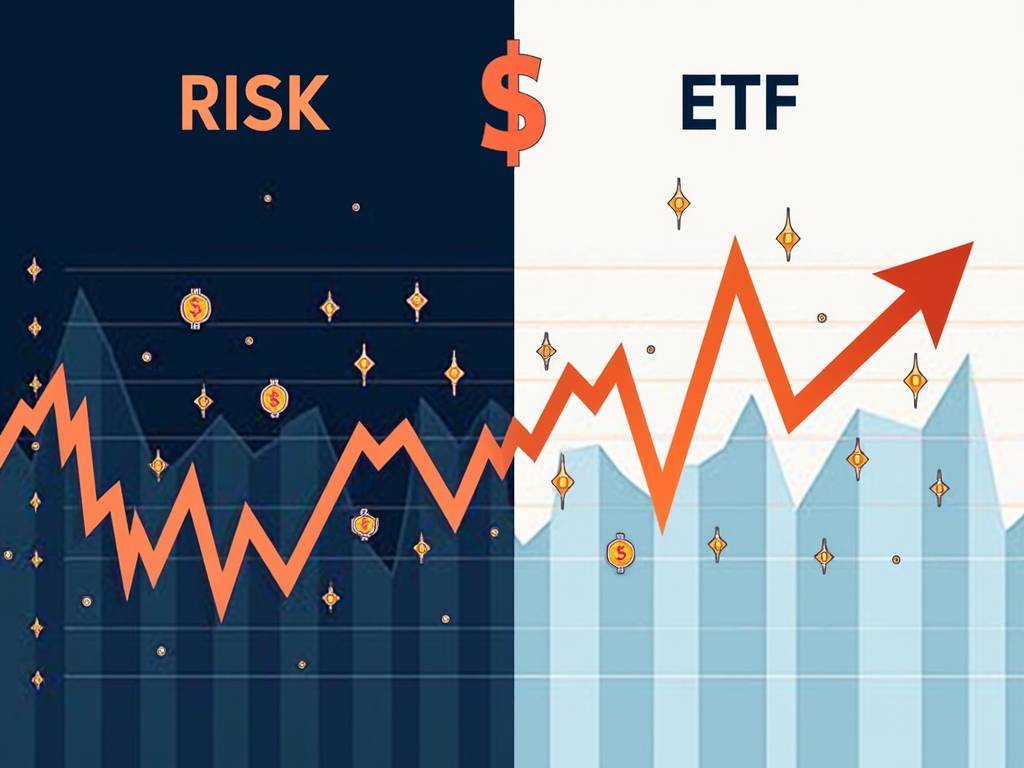The financial world finds itself at a crossroads between the traditional and the innovative. While traditional ETFs have offered stability and diversification for decades, cryptocurrencies attract riskier investors with their high potential returns and technological innovations. In this article, we examine the main differences and similarities between these two asset classes. The first section focuses on the risk-return profile, while the second compares diversification opportunities and trading practices.
The Landscape of Volatility: Risk and Opportunity in Cryptocurrencies and Traditional ETFs

Cryptocurrencies and traditional ETFs are asset classes that present exciting decisions for both inexperienced and experienced investors. Although both options offer different risks and opportunities for returns, each represents a unique investment horizon through its own structure and function.
Cryptocurrencies:
Cryptocurrencies like Bitcoin and Ethereum are both attractive and daunting for investors due to their immense volatility. This form of digital currency can experience massive price fluctuations within a few days, which can translate into gains of up to 300% over the course of a year, as seen with Bitcoin in 2021. However, this effectiveness comes with high unpredictability and uncertainties, not least due to regulatory fluctuations worldwide. The high correlation of Bitcoin with traditional stock markets means that during periods of high volatility, it may not provide the expected protection.
Investors looking to capitalize on these strong fluctuations should be aware of a rigorous and diversified investment strategy to spread the risks. This ensures that potential gains are maximized while the investment is protected from market swings.
Crypto ETFs/ETPs:
A new trend in the field of cryptocurrencies is the possibility of investing through ETFs or related products such as ETNs and ETPs. These offer investors simplified access to the volatile cryptocurrency markets. However, while they reduce technological complexity, they also come with their own risks, particularly regarding regulatory restrictions, such as the ban on cryptocurrency ETFs in Germany. These products not only face tax challenges but also a greater risk for the issuer, making them still a high-risk investment.
Traditional ETFs:
In comparison, traditional ETFs offer a bastion of stability for more conservative investors. These ETFs invest in a variety of assets, from stocks to bonds to commodities, are less volatile, and provide a more stable anchor in an often unpredictable financial horizon. They benefit from strict regulatory standards that enhance transparency and security for investors.
In summary, the decision between cryptocurrencies and traditional ETFs depends on the investor’s personal goals and risk appetite. Cryptos offer the promise of high profits but at the cost of significant instability. Traditional ETFs, on the other hand, represent the conventional wisdom of diversification and stability.
Diversification and Trading Mechanisms: A Comparison of Cryptocurrencies and ETFs

Cryptocurrencies have not only revolutionized the traditional understanding of money but also the way investors think about portfolio diversification. While traditional ETFs rely on an established structure and allow investors to access a wide array of assets, cryptocurrency ETFs bring a fresh approach to diversification strategies.
In their basic approach, traditional ETFs offer a multitude of diversification possibilities. These investment funds generally comprise a variety of stocks or bonds that are spread across different sectors and geographical regions. An ETF that replicates the S&P 500, for example, not only brings stability but also a strategic safeguard against collapses in individual sectors. Such ETFs are always traded in regulated markets, providing additional security and transparency.
In contrast, cryptocurrency ETFs present a new opportunity for diversification within digital assets. Instead of having to deal with the complex matter of wallets and key management, investors gain an accessible way to invest in multiple cryptocurrencies simultaneously. A significant advantage of this approach is the reduced individual risk associated with investing in single highly volatile cryptocurrencies. ETF products that comprise a variety of cryptocurrencies offer investors the opportunity to benefit from the overall development of the cryptocurrency market without having to bet directly on individual coins.
The trading practices of both types of ETFs differ significantly. While traditional ETFs are traded exclusively during market opening hours, cryptocurrency ETFs offer a more flexible trading experience, often available 24/7, as they are offered on newer trading platforms. This increases accessibility and convenience for modern investors who wish to benefit from rapid market fluctuations. Additionally, cryptocurrency ETFs greatly simplify entry into the cryptocurrency market, as no technical knowledge of blockchain technologies is required.
However, the risks associated with cryptocurrency ETFs and cryptocurrencies must not be underestimated. Volatility and often still undefined regulatory requirements present significant challenges. It remains to be seen whether the potential gains align with the associated risks. In the traditional ETF sector, there is greater predictability, as they rely on more established and therefore more predictable markets.
In summary, cryptocurrency ETFs offer an interesting expansion for an investor’s portfolio, especially for those looking to participate in the promising development of digital currencies without having to directly bet on individual highly volatile cryptocurrencies. Their introduction as regulated investment products could pave the way for more investors to enter this dynamic market.